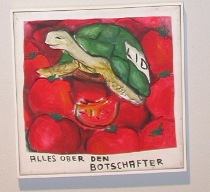
I went to the press preview of the Jorg Immendorff show and because it was so sparsly attended (as in me and Mr. Sozanski) I got a one-on-one walk-through with curator Pamela Kort, a bouncy, no-nonsense enthusiast for all things Immendorff. Mr. S. squared off with Robert Storr, the show’s other curator. (image top is an early Immendorff work. The turtle, says Kort, is innocence, is him.)
Kort and I started off on a rocky footing…
She: Anything you want to know… just ask me.
Me: (not knowing anything and not having a question in my head) …there’s sure a lot of German words in the paintings. It would help to know some German….
She: Well, he is a German artist.
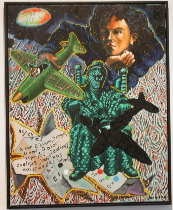
After that, shall we say curt Kort exchange, we cruised nicely, and the curator was a delightful guide, someone who must have always been the smartest kid in the classroom and who’s happy to share. (Storr, by the way, was the other smartest kid in the class.)
Kort was invited to co-curate the show by Storr. She’s American but lives in Germany and has written several books on Immendorff. She also worked with the artist on a recent project, the opera “The Rake’s Progress,” which the artist turned into a story about himself and the art world (he’s the Rake).
Kort told me the artist was a Maoist student revolutionary in the 1960s. He was also a utopian thinker. One of his art projects was the creation of an imaginary art academy, “Lidl” (pronounced “little”).
Lidl, which riffed on things diminutive, and, says Kort, was a stand-in for the artist, had a small faux building which he put inside a little classroom at Dusseldorf Academy. Immendorf drew up a campus plan, even painted a mascot for the school, a dog.
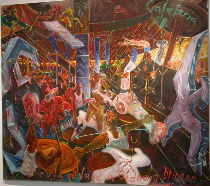
(Image left is from the “Cafe Deutschland” series)
Immendorff was a performer and would walk around with a “Lidl” flag which he would put in various classrooms. Kort says this was like him saying “Here I am, Lidl, “ich.” (There’s a painting of him carrying the Lidl flag in the exhibit.)
Another time, he walked around the city with a wooden brick tied to his leg. The brick was painted the colors of the German flag and labelled “Lidl.” He was arrested for desecrating the German flag. (The brick is in the show, too.)
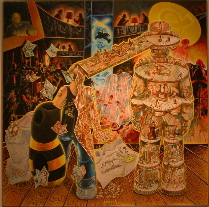
Kort says the artist’s work has always been about himself and about art and the role of the artist and that his oervre has been about “refining this disposition.”
Much of the work in the show has never been seen by an American audience. For some reason, a few pieces belong to a corporation in Iowa.
“He’s not afraid of erotic energy,” says Kort, who pointed out an example (a unisex three-way in the Rake’s Progress painting). (image above is “Rake’s Progress”)
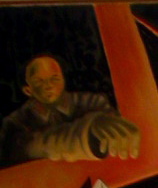
“The work is very contemporary. That’s the reason we did the show now. Young people are interested in this…[self-referential utopian art-making]
“I don’t know much about politics but I know a lot about art,” said Kort, who then went on to talk about Marxist-Leninist theory.
She also pointed out Immendorf’fs Mao-love which continues up to the moment. In fact, you can make a “Where’s Mao” game searching amidst the layers and layers of imagery in the Cafe Deutschland and Cafe Flor paintings. (Hint, look up and left — of course.) (see detail above from “Rake’s Progess” for example)
The show was called “I wanted to be an artist” for two reasons. First, Immendorff himself wanted that title. Secondly, the phrase refers to an early sequence of paintings in the show, a group of works called “I wanted to be an artist.” The picture and word pieces form the artist’s Marxist-Leninist self-critique.
In sum, go see this show. It’s a high flying burst of energy by an artist, who, I’m told, by the way, is seriuosly ill with ALS.
Storr and Kort are hoping this major exhibit convinces a U.S. museum to mount a show of Immendorff’s work. I’d say they’ve got a case.









